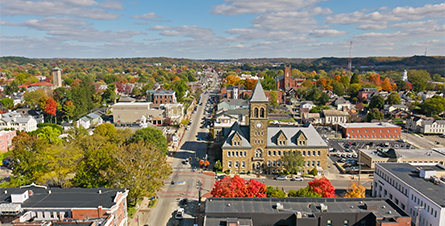Public Utilities, Public Trust: Navigating Funding Challenges
10.20.25
Public utilities operate at the intersection of public health, infrastructure demands, and public trust. They must consider a variety of competing factors when deciding where to invest and how to secure funding for their investments, all while prioritizing trust and transparency with their community members.
Ensuring access to safe drinking water is a key focus area for utilities and other public agencies. However, funding such efforts can be challenging, especially as regulatory changes related to ‘forever chemicals’ like per- and polyfluoroalkyl substances (PFAS) and other contaminants introduce additional budget stressors — and mounting public pressure.
Agencies rely on several common sources, such as federal programs, bonds, and rate increases to recover costs and secure funds for ongoing and future projects. However, they must often complete rigorous, time-consuming applications in order to access these funds. Even then, they may not be enough to cover all the costs related to:
- Infrastructure improvements
- Accessing alternative water sources
- Operating and maintenance costs
To keep up with compliance regulations, community needs, and public demand, utilities need a diverse financial strategy that leverages multiple funding sources in tandem.
By combining funds from grants, federal programs, and other alternative funding sources such as water contamination litigation, agencies can strengthen their budgets and meet financial needs while minimizing rate impacts and ensuring that costs are borne by the responsible parties rather than ratepayers.
Funding obtained through legal proceedings, whether achieved through a settlement or trial verdict, can be a powerful financial tool for utilities and other public agencies. Integrating litigation into your agency’s financial strategy is about building future resilience. It’s important to recognize that legal proceedings may take time and are best for funding long-term plans rather than immediate needs.
In this post, we’ll explore how your agency can leverage litigation to cover existing or anticipated costs and overcome funding challenges without compromising accountability or transparency with your community members.
Public Utilities and the Burden of Accountability
Utilities often face intense public scrutiny and regulatory oversight regarding the presence of contaminants in public water systems. They are tasked with addressing pollution in an efficient, cost-effective manner while prioritizing citizens’ safety and well-being. It’s extremely challenging to strike this balance while operating with limited funding and a long list of priorities.
Each infrastructure decision must balance affordability, public safety, and transparency.
Decisions related to water contamination remediation are a top priority for many agencies and their communities, especially as awareness of the widespread presence of chemicals like PFAS in public water systems increases and new regulations are put in place to determine liability for remediation.
Whether discovered through required testing or a specific pollution event, water contamination can be complex and costly to remediate. Although manufacturers and other third parties are the ones responsible for the contamination, public utilities are tasked with funding and carrying out the cleanup efforts and associated infrastructure changes, further stretching their already tight budgets.
Understanding the Funding Gap — and Why It’s Growing
Public agencies have long faced an uphill battle to secure sufficient funds for various infrastructure, environmental, and public safety-related projects, leaving them to make complicated, sensitive decisions about which projects to prioritize. This challenge is becoming even more complex as awareness around water contamination — and related regulations — come into play.
In fact, EPA's 7th Drinking Water Infrastructure Needs Survey and Assessment (DWINSA) estimates that water systems in the United States will need $625 billion for pipe replacement, treatment plant upgrades, storage tanks, and other key assets over the next two decades.
While public financing programs like State Revolving Funds (SRFs) and the Water Infrastructure Finance and Innovation Act (WIFIA) provide funding opportunities, these options can be competitive, slow-moving, and financially insufficient, further widening the infrastructure funding gap many public agencies now face.
Public water systems primarily rely on ratepayer revenue to fund operations and infrastructure improvements. However, raising rates is rarely a simple decision — utilities must weigh public needs, political considerations, and the reliability of other funding sources. These factors often delay or limit the ability to secure sufficient funds through rate adjustments alone.
To bridge the gap, many agencies turn to public financing programs such as State Revolving Funds (SRFs) and the Water Infrastructure Finance and Innovation Act (WIFIA). While these programs provide valuable funding opportunities, they can also be competitive, slow-moving, and financially insufficient — further widening the infrastructure funding gap many public agencies now face.
So, how can agencies secure additional funding while preserving community trust?
Litigation as a Strategic Cost Recovery Tool
Water contamination litigation is not only essential for holding polluters accountable for the harm they cause; it also gives utilities an opportunity to recover the costs of remediation and infrastructure improvements — so that polluters, not local ratepayers, bear the financial burden of contamination.
Funding via litigation is never a guarantee, but the right legal team can give your agency the best chance of achieving a positive result by helping identify:
- Tracing contamination back to responsible polluters — and, when needed, recommending additional testing to strengthen the case.
- Applicable laws and regulations in your state, as well as other ongoing cases related to your own
- An ideal path forward for legal recourse
You may be able to obtain funding via litigation before your agency has invested in remediation. A law firm with experience in water contamination litigation can provide strategic guidance based on its work with water agencies and cases similar to yours. A team with the right experience should also minimize the administrative burden on your staff.

Depending on the type of contaminant and regulations in your area, litigation can help your agency fund various projects related to contamination, including:
- Well replacement and the modernization of water treatment infrastructure
- Long-term operating and maintenance costs for your water system
- System-wide upgrades in anticipation of upcoming regulations
Guidelines around when you can pursue legal action and how your agency may use the resulting funds varies based on the contaminant impacting your water system. That’s why it’s critical to partner with a firm that’s well-versed in this type of litigation and knowledgeable about the latest regulatory developments.
Maintaining Public Trust While Pursuing Legal Action
You might worry that pursuing legal action against polluters will draw negative attention to the contamination of your public water systems or cast blame onto other agencies in your community. Approached properly, however, they are an opportunity to strengthen the public’s trust in your agency.
Communities welcome action that protects ratepayers and public health, which means a proactive, transparent communication and PR strategy can actually have a positive impact on your public reputation, further building trust between your agency and those in your community.
Inform community members not only of your plans to take legal action, but why your agency has chosen that option — so that your community doesn't have to bear the costs of pollution it didn’t cause.
Lawsuits aren’t about assigning blame on the local level; they’re about holding the responsible manufacturers accountable for polluting your water system. Keeping the public well-informed about the litigation ensures their concerns focus on achieving that goal.
Choosing the Right Legal Partner
While your utility will lead public communications surrounding your decision to pursue litigation, a law firm with experience in water contamination litigation will help you navigate the legal process with minimal disruption and administrative burden.
A firm that understands both the intricacies of water contamination litigation and how public utilities operate can streamline the legal process and give your agency the best possible chance of effecting a positive outcome.
Your legal partner will use the knowledge of your water sources and existing infrastructure to create a clear picture of how contamination might have happened, how contaminant levels might change over time, and your potential for legal recovery.
They can also complement your technical expertise with legal and regulatory insight — from emerging regulations to litigation trends and active cases. Together, this information helps chart the best path forward.
What to Look for in a Law Firm
- Experience in water contamination litigation, including both taking cases through trial and appeals, and representing clients in MDLs.
- Contingency-based billing that enables your agency to pursue litigation with no upfront legal costs, and fees apply only if a recovery is made through settlement or judgment.
- An in-depth understanding of water systems and how utilities operate and maintain them.
Ultimately, partnering with a knowledgeable firm can enhance your claims’ potential and minimize the litigation burden by guiding you through each step of the legal process.
Sustainable Infrastructure Starts with a Diverse Financial Strategy
Litigation isn’t a replacement for public funding, but it can complement it by filling critical financial gaps. It can serve as a broader, long-term funding strategy to manage your agency’s financial risks.
Pursuing cost recovery through litigation is especially worthwhile alongside grants and similar programs, as it doesn’t depend on political goodwill or federal funding to support infrastructure and safety improvements in your community.
What’s more, acting proactively positions your utility ahead of enforcement timelines and avoids leaving money on the table, enabling your utility to better manage future costs while protecting those in your community.
To explore whether litigation could be part of your long-term financial plan, contact our team or dive into our guide, Water Contamination Litigation: Essential Strategies for Municipal Budget Management, for more insights and related resources.



